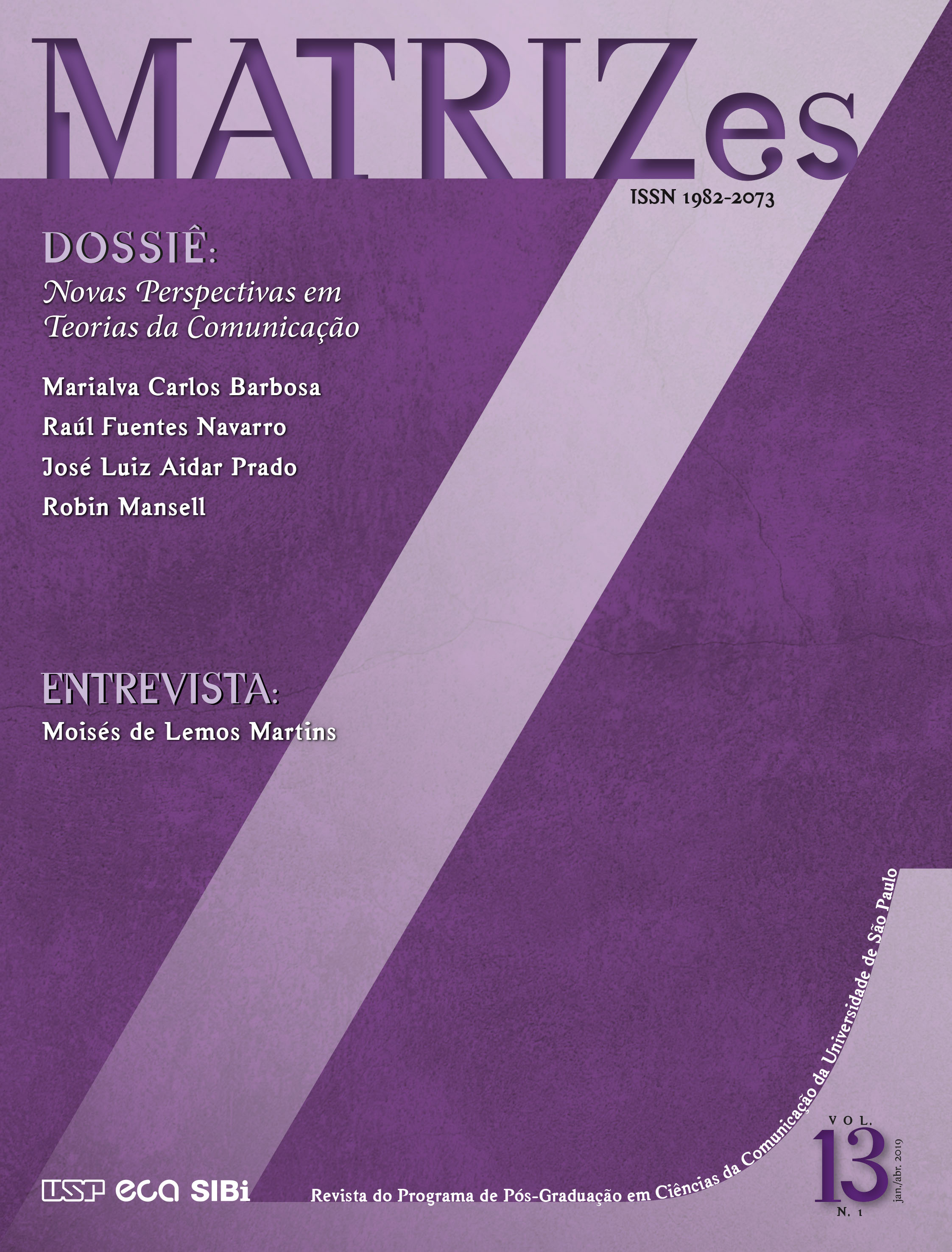They grew up so fast: Cartoon Network in connection with the Jorel’s Brother Brazilian cartoon
DOI:
https://doi.org/10.11606/issn.1982-8160.v13i1p211-229Keywords:
Cable TV, television cartoon, Cartoon Network, Jorel’s BrotherAbstract
This study aims to understand how the transnational channels interact with national contents considering the consolidation of Cartoon Network Brazil and an analysis of the Brazilian cartoon Jorel’s Brother, produced in Brazil in partnership with the channel that broadcasts it. The results show this TV cartoon incorporates diverse local characteristics, linked to the place where it is produced, while exploring global elements in its narrative, which are internationally recognized. However, the definition of global reinforced by Jorel’s Brother cartoon is closely related to the US media context, which marks a selfcentered and self-referential approach around the Cartoon Network.
Downloads
References
Associação Brasil Audiovisual Independente. (2015, 9 de março). Irmão Jorel é o desenho mais visto do Cartoon em 2014. Recuperado de https://goo.gl/t99AZw.
Associação Brasileira de TV por Assinatura (2019). Dados do setor. Recuperado de https://bit.ly/2UNil7U.
Chalaby, J. (2002). Transnational television in Europe: The role of Pan-Europeans Channels. European Journal of Communication, 17(2), 183-203. doi: 10.1177/0267323102017002692
Chalaby, J. (2009). Transnational television in Europe: Reconfiguring global communication networks. Londres, UK: IB Tauris.
Chris, C. (2002). All documentary, all the time? Discovery Communications Inc. and trends in cable television. Television & New Media, 3(7), 7-28.
Confira o ranking dos 20 canais mais vistos na tv paga em 2016. (2017, 5 de janeiro). O universo da TV. Recuperado em https://goo.gl/8FS81a.
Coutinho, I. & Mata, J. (2010). Uma programação para chamar de sua: Televisão, narrativa e participação popular. Contemporânea, 8(2), 1-19. doi: 10.9771/1809-9386contemporanea.v8i2.4788
Expedia. (2019). Parque Aquático Cartoon Network Amazone na Tailândia. Recuperado de https://bit.ly/2y1VLyp.
Gatti Junior, W. & Marietto, M. L. (2017). Como pode um peixe vivo viver fora do Brasil? O caso Peixonauta. Revista Ibero-Americana de Estratégia, 16(4), 110-116. doi: 10.5585/riae.v16i4.2512
Holzbach, A. (2016). A invenção do videoclipe: A história por trás da consolidação de um gênero audiovisual. Curitiba, PR: Appris.
Jambeiro, O. (2001). A TV no Brasil do século XXI. Salvador, BA: Edufba.
Jaramillo, D. (2002). The Family Racket: AOL Time Warner, HBO, The Sopranos, and the Construction of a Quality Brand. Journal of Communication Inquiry, 26(1), 59-75. doi: 10.1177/0196859902026001005
Latin American Multichannel Advertising Council. (2018). As métricas da TV por assinatura. Recuperado de https://goo.gl/Ahd63h.
Lopes, M. I. V. (2003). Telenovela brasileira: Uma narrativa sobre a nação. Comunicação & Educação, 1(26), 17-34. doi: 10.11606/issn.2316-9125.v0i26p17-34
Lopes, M. I. V. (2009). Telenovela como recurso comunicativo. Matrizes, 3(1), 21-47. doi: 10.11606/issn.1982-8160.v3i1p21-47
Lopes, M. I. V. (2010a). Ficção televisiva e identidade cultural da nação. Revista Alceu, 10(20), 5-15. Recuperado de http://bit.ly/2GTQnQ3
Lopes, M. I. V. (2010b). A telenovela como narrativa da nação: Para uma experiência metodológica em comunidade virtual. Signo Y Pensamiento, 2(57), 130-141. Recuperado de http://bit.ly/2LfFAEh
Mittell, J. (2004). Genre and television: From cops shows to cartoons in American
culture. Nova York, NY: Routledge.
Morisawa, M. (2001). Carlos Tureta: A voz do Cartoon Network. Isto é Gente, 105. Recuperado de https://goo.gl/8cNh9p.
Ribeiro, A. P. G., Sacramento, I., & Roxo, M. (Eds.). (2010). História da TV no Brasil: Do início aos dias de hoje. São Paulo, SP: Contexto.
Sabino, R. (2017, 17 de julho). Desenhos animados brasileiros fazem sucesso na televisão. Correio Braziliense. Recuperado de https://goo.gl/9iZ5zC.
Sandler, K. (2003). Synergy nirvana: Brand equity, television animation, and Cartoon Network (pp. 89-109). In C. Stabile & M. Harrison, Prime Time Animation: Television animation and American culture. Londres, UK: Routledge.
Silva, F. M. (2009). Talk Show: Um gênero televisivo entre o jornalismo e o entretenimento. E-Compós, 12(1), 1-16. doi: 10.30962/ec.v12i1.289
Silva, F. M. (2010). Apontamentos para uma história cultural dos talk shows brasileiros. Em Questão, 16(2), 119-133. Recuperado de http://bit.ly/2PCCtVo
Silva, F. M. (2013). Marcos históricos do talk show no Brasil: Uma análise dosprogramas Globo Gente e Jô Soares Onze e Meia. Galáxia, 25, 123-134. Recuperado de https://revistas.pucsp.br/galaxia/article/view/10279/11390
Souza, J. C. A. (2015). Gêneros e formatos na televisão brasileira. São Paulo, SP: Summus.
Waisbord, S. (2004). McTV: Understanding the global popularity of television formats. Television & New Media, 5(4), 359-383. doi: 10.1177/1527476404268922
Zelizer, B. (1992). CNN, the Gulf War, and journalistic practice. Journal of Communication, 42(1), 66-81. doi: 10.1111/j.1460-2466.1992.tb00769.x
Downloads
Published
Issue
Section
License
Copyright (c) 2019 MATRIZes

This work is licensed under a Creative Commons Attribution-NonCommercial-ShareAlike 4.0 International License.
Authors who publish in this journal agree to the following terms:
- Authors retain the copyright and grant the journal the right to first publication, with the work simultaneously licensed under the Creative Commons Attribution License (CC BY-NC-SA 4.0) which allows sharing of the work with acknowledgment of authorship and initial publication in this journal for non-commercial purposes.
- Authors are authorized to assume additional contracts separately, for non-exclusive distribution of the version of the work published in this journal (eg, publishing in institutional repository or as a book chapter), with acknowledgment of authorship and initial publication in this journal.






















